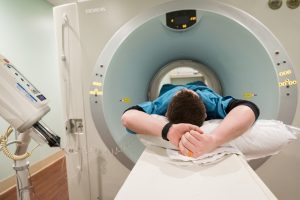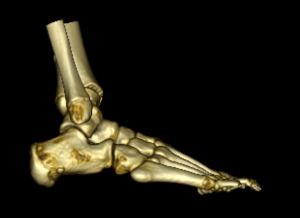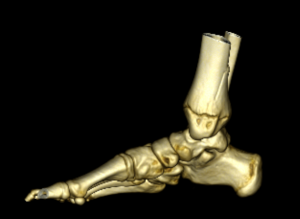What is a CT Scan?
 Some people refer to a CT scan as a CAT scan, which stands for computerized axial tomography.
Some people refer to a CT scan as a CAT scan, which stands for computerized axial tomography.
A computed tomography CT (CAT) Scan allows doctors to see inside your body using a combination of X-rays and a computer to create pictures of your organs, bones, and other tissues.
CT scans show more detail than a regular X-ray providing a series of images from many different angles. A computer uses this information to create a cross-sectional picture. Like one piece in a loaf of bread, this two-dimensional scan shows a “slice” of the inside of your body. Enhancements in 3D reconstruction can also provide Doctors with images that represent a 3D model of the anatomy.
What Is a CT Scan Used For?
CT scans are used to detect bone and joint problems, like complex bone fractures and tumors.
- If you have a condition like cancer, heart disease, emphysema, or liver masses, CT scans can spot it or help doctors see any changes.
- They show internal injuries and bleeding, such as those caused by a car accident.
- They can help locate a tumor, blood clots, excess fluid, or infection.
- Doctors use them to guide treatment plans and procedures, such as biopsies, surgeries, and radiation therapy.
- Doctors can compare CT scans to find out if certain treatments are working. For example, scans of a tumor over time can show whether it’s responding to chemotherapy or radiation.
When does a CT Scan need to be used with Contrast
In a CT scan, dense substances like bones are easy to see. But soft tissues don’t show up as well. They may look faint in the image. To help them appear clearly, you may need a special dye called a contrast material. They block the X-rays and appear white on the scan, highlighting blood vessels, organs, or other structures.
Contrast materials are usually made of iodine or barium sulfate. You might receive these drugs in one or more of three ways:
- Injection: The drugs are injected directly into a vein. This is done to help your blood vessels, urinary tract, liver, or gallbladder stand out in the image.
- Orally: Drinking a liquid with the contrast material can enhance scans of your digestive tract, the pathway of food through your body.
- Enema: If your intestines are being scanned, the contrast material can be inserted in your rectum.
After the CT scan, you’ll need to drink plenty of fluids to help your kidneys remove the contrast material from your body.


Are there Side Effects
An allergic reaction to the contrast material can occur, however uncommon and usually any reaction is mild. Possibly leading to itchiness or a rash. If you have had a reaction in the past or have any allergies to medications, seafood, or iodine please inform you Doctor as a premedication maybe advised.
What You Need to Know

CT scans use a small amount of X-ray radiation to generate images. A patient’s exam dose is customized to ensure the best possible image quality while minimizing radiation dose.
A CT scan can be safely performed if you have an implanted device, such as an insulin pump or pacemaker. The technologist will leave the room during the scan, but the person can talk to you via an intercom.
The machine is relatively quiet.
The uses of CT and MRI scans are very similar. CT scans are more common because they are less expensive and still provide good detail. A doctor may order an MRI scan when they need to create more accurate, detailed images of the body.
Why might you be asked to drink oral contrast
For many types of abdominal and pelvic examinations, you will be asked to drink specific liquids (“oral contrast agent”) while in the waiting room before your examination, or occasionally before coming to the office. Most commonly, a dilute solution of barium is used to improve visualization of the stomach, small bowel and colon. It helps to identify diseases affecting the bowel itself; possible sites of stricture or obstruction; and to distinguish the bowel from otherwise similar appearing abnormalities like cysts or abscesses. Some patients find the taste of the contrast material slightly unpleasant, but tolerable. Occasionally dilute iodine-based oral contrast agents are added or substituted. Before the actual scan is performed, you may need to wait for the contrast agent to pass throughout the colon, while sipping more to keep the upper part of the intestine filled.
For some types of exams, usually for evaluation of the kidneys, urinary tract, or blood vessels, you will be asked to drink water instead.
Very rarely, at the time of the scan itself, some contrast agent will be administered as an enema, through a stoma or catheter in post-operative patients.
What is IV contrast, why and when is it used
Sometimes iodinated contrast material is injected into a vein during the course of the examination to accentuate the difference between normal and abnormal tissue in organs like the liver, pancreas or kidneys. The contrast agent passes through the bloodstream, allowing images of the blood vessels to be acquired (CT angiography). From there it passes into the organs, each of which when normal acquires a characteristic appearance at various times following injection. Alterations in the enhancement patterns yield diagnostic information about the health of the organs or characterize smaller abnormalities within them. Solid nodules can be distinguished from cysts. The kidneys remove the contrast agent from the blood, sending it down the ureters into the bladder where it can then be excreted, facilitating assessment for obstruction and permitting better visualization of the usually inconspicuous ureters and bladder lining.
